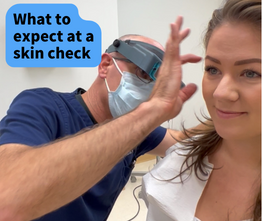At a skin check, we are looking for any evidence of skin cancer. Skin cancer is the most common form of cancer in men and women and Idaho consistently ranks in the top 10 states with the highest incidence and death rates for skin cancer. Schedule online now!
Who should have this done and how often?
If you have a family history of skin cancer, suntan or use tanning beds, you’re at increased risk and we recommend that you come once a year, or more often if you have a history of skin cancer, for a full-body, professional skin exam. Otherwise, it’s wise to have a skin check whenever you notice concerning spots.
Melanoma before age 30 is rare, but does happen. By age 50, it is not uncommon. After your first skin check, you and your provider can discuss when a return visit should happen. If nothing is found, you may not need to come back yearly, if a skin lesion is concerning or you have a history of skin cancer, a 6 month check may be recommended. Remember that skin changes can happen fast and an annual exam will help cancers be found early. Also, consistent exams help keep a record of your skin’s health and appearance from one year to the next.
What exactly does a skin check involve?
When you come to our office for a skin check, the exam shouldn’t take more than 15 minutes. It is not necessary, but is helpful to take off any jewelry, nail polish and makeup beforehand. Remember to bring a current list of medications, your insurance card and ID.
Our medical assistants will show you to the exam room and make sure our records are correct— including confirming information about your primary care provider, pharmacy, medications, etc.
You will be asked to remove your clothing to your level of comfort in privacy but to keep undergarments on. A gown will be given to you to wear that will cover parts of the body not being examined.
After you have been given time to change, the provider and medical assistant will return to the room for the exam.
Your provider will likely ask:
- Have you ever seen a dermatologist before?
- Do you have a family with a history of skin cancer
- Do you have any areas of concern?
It’s a good idea to think about these things before arriving.
The provider will methodically and carefully examine your skin from head to toe. He or she will then methodically examine each area of the body — including the scalp and bottom of the feet and the torso. If you have areas of particular concern located in areas covered by your underwear, you can give consent to inspect them, provided you are comfortable with that.
What happens if something is found?
If a suspicious area is encountered, a biopsy may be performed. During a biopsy all or part of the lesion may be removed. The specimen is put in a container and taken to our modern in-house lab that is staffed by 3 skilled dual board-certified dermatopathologists to help with efficient, timely diagnoses. If the report comes back that the spot is skin cancer, we will contact you and explain the type of skin cancer and treatment options.
Finding this early is optimal and the key to the most minimal and cost-effective treatment with the highest chance of a cure.
Can I check my own skin?
Yes! The American Academy of Dermatology Association has a great method for self-exams outlined here. Though you might need help from a spouse or a mirror for the hard-to-see ares, you should always do your best to monitor your skin. After all, it is the only organ on the outside of our body regularly exposed to the sun. Notice and record any spots, moles or marks that:
- Have changed in size, shape or color over time
- Bleed or do not heal after weeks
- Are asymmetrical and/or have irregular borders
- Are larger than 6mm / 0.25″
Show your tell your provider about these things in order to prevent the potential development of skin cancers and melanoma.
Schedule online! You’ll be able to choose a provider based on clinic location and availability. Sometimes new patient visits book out further, but if you need help, please call our scheduling department at (208) 884-3376.




